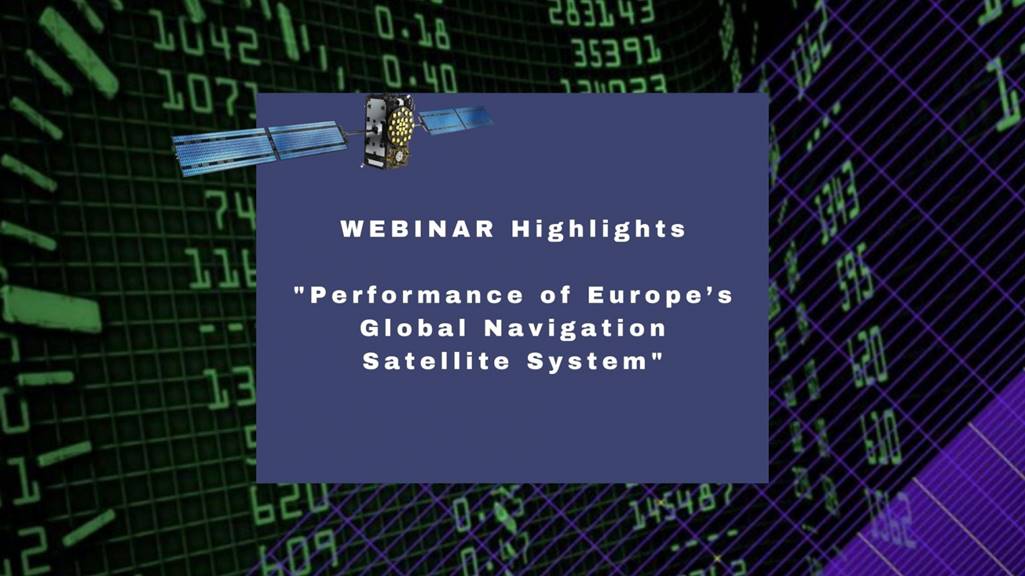The European GNSS Global Navigation Satellite System Agency (GSA) organised an online workshop on 3 March to provide an in-depth analysis of the performance of Galileo and show how this performance is evaluated and how it is crucial for service provision in every user application.

The Galileo Performance Workshop 2021 provided an in-depth analysis of Galileo’s performance.
The workshop focused in particular on the Galileo Open Service (OS) as defined in the OS Service Definition Document (SDD) and the Programme’s needs for performance monitoring against the defined Minimum Performance Levels (MPLs) and Key Performance Indicators (KPIs). Attention was also paid to publicly available data, products and tools that can be used for GNSS monitoring. In addition to the GSA, the workshop involved representatives of the European Commission, the European Space Agency (ESA) and of the EU Member States and gathered nearly 500 participants.
Workshop outcome
At the workshop, a number of technical topics were addressed.
- All presenters confirmed that the Initial Services commitments as described in the OS SDD are met, some events were observed and discussed, but the Galileo performance, also compared to other GNSS, especially in terms of accuracy is good.
- When monitoring the performance of Galileo, it is important that the satellite health status should be verified for F/NAV and I/NAV ephemerides using broadcast navigation data consolidated from a global network. However, there is no standard on how to generate a consolidated navigation message from publicly available data– the quality and availability depends on latency of this data.
- It is important for users to check the status of the navigation messages as specified in the Galileo OS Signal-in-Space (SiS) Interface Control Document (ICD) and the SDD. This requires that the receivers monitor the Signal-in-Space health flags: signal health status (SHS), data validity status (DVS) and Signal-In-Space accuracy (SISA). The Galileo system uses these three SiS health flags to protect users, and all of them need to be monitored and appropriate actions taken as specified in the ICD. Both the ICD and SDD are available for download on the website of the European GNSS Service Centre (GSC).
Read this: EUSW - status of Galileo services
- With respect to using reference stations for performance monitoring, it is recommended to use a geodetic grade receiver connected to a geodetic antenna. This generates high-quality data using multiple frequencies and signals.
- Real-time data provides an overview of GNSS status in nominal situations. However, not all information from the signals required for monitoring is available in the real-time streams using the RTCM standard. Some sources also provide real-time broadcast orbit and clock corrections in the state space representation (SSR) format, yet unusual events and anomalies might not be reflected properly in these streams, as the underlying processing software might not be able to handle those events well.
- The Galileo Service Operator runs the system to maintain the performance specified in the SDD. Performance may vary within set margins due to operational, maintenance or deployment constraints. In light of this, interpretation of results is key for proper GNSS performance monitoring. It is good practice to make use of redundancy and always to confirm results with other sources, when possible.
Galileo Reference Centre
The GSA has established the Galileo Reference Centre (GRC) with a primary mission of providing an independent means to monitor and evaluate the performance of the Galileo services and the quality of the Signal-in-Space. The GRC is the European hub for these activities, integrating contributions from European national entities, such as research centres, timing laboratories, and national space agencies.
Watch this: Galileo Reference Centre
Performance is measured against Key Performance Indicators (KPIs), the computation of which depends on GNSS data measurements and derived reference products (e.g. precise orbits, satellites clock corrections). It can also be assessed based on publicly available data and products, which exist with various levels of quality, reliability and latency. To be able to compare results obtained by independent sources, it is important to have a common understanding, guidelines for monitoring and a sound assessment methodology. This is what the Galileo performance workshop aims to provide.
All the presentations delivered during the workshop are now available here.
Media note: This feature can be republished without charge provided the European GNSS Agency (GSA) is acknowledged as the source at the top or the bottom of the story. You must request permission before you use any of the photographs on the site. If you republish, we would be grateful if you could link back to the GSA website (http://www.gsa.europa.eu).